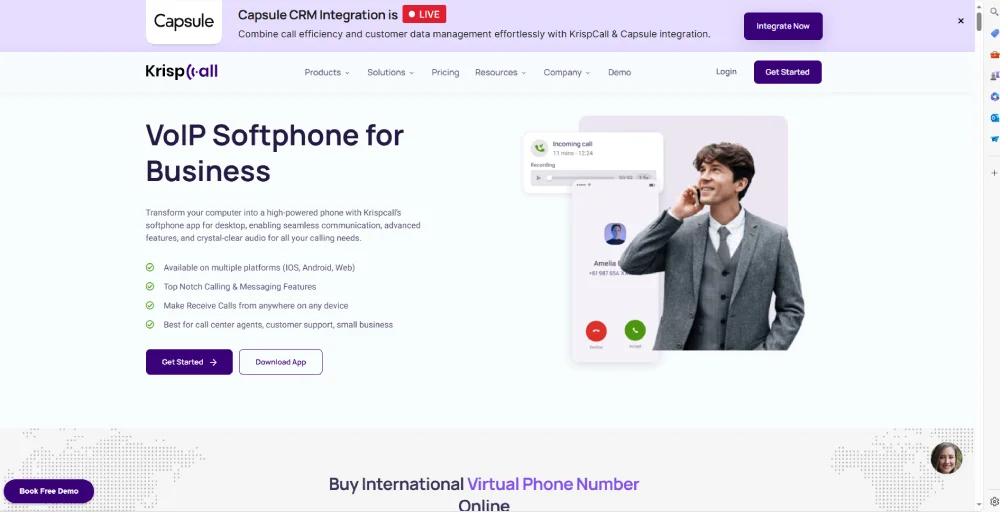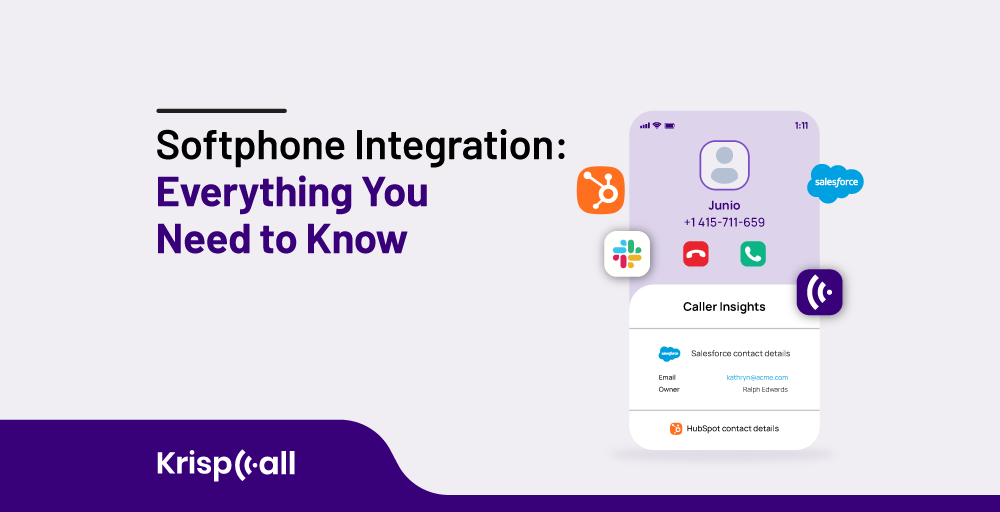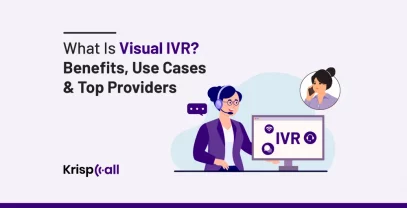Changes in the virtual world have made it apparent that flexibility in communication solutions is critical. Originally, the term “softphone systems” was used as a substitute for business communications, but now its use has been replaced with a newer appropriate category, including “unified communications.”
Business phone calls that used to take place via traditional desktop units are now a thing of the past as internet phone calling has been established with the help of Softphone systems with added features such as mobility.
In this article, we will cover everything you need to know about Softphone Integration, its benefits, where you must implement it in your business, and how you can do it.
🔑 KEY HIGHLIGHTS
- Softphone is a software solution that facilitates voice communication through a computer using internet protocol rather than physical hardware.
- Increased Efficiency, Reduced Cost, enhanced customer experience, and increased employee satisfaction are some of the benefits of softphone integration.
- The integration of softphones in a business depends on some factors and conditions that meet the requirements of the business environment and the business’s operations.
- Integrating KrispCall Softphone can also improve your business communication by reducing call quality, enhancing productivity and cost, and creating a better customer and employee experience.
What is Softphone Integration?

Softphone integration can be defined as the act of incorporating a software-based telephone system (softphone) into another application or system. This involves linking disparate systems, databases, and functionalities to enable data sharing, communication, and collaboration between them.
The integration can take place down different levels: application integration that is within the platform (e.g., by integrating modules of an enterprise resource planning system), application integration where it integrates different application systems (e.g., by integrating a customer relationship management system with an email marketing platform ) or the integration of the system with external systems or APIs (e. g. Integrate payment processing functionality into an e-commerce website).
Benefits of Softphone Integration.
The integration of softphone systems in the business has several advantages, including enhancing communication efficiency and flexibility.
Here are just a few of the key benefits:
- Increased Efficiency: They are characterized by high communication and data exchange delivery efficiency, contributing to increased work pace and fewer resources used to provide value-added services.
- Reduce Costs: It helps businesses avoid spending money on desk phones and the accessories associated with them, and hence, they stand to enjoy significant savings.
- Enhanced Customer Experience: It ensures an easy flow of communication and personalized experience to optimize the users’ calling experience.
- Increased Employee Satisfaction: It eases employees’ workloads and is convenient for calling regardless of missing calls and normal phone activities.
- Scalability: It ensures room for expansion; that is, when the business expands, the phone lines and accounts can be easily expanded without losing their functions.
- Portability: It enables users to conduct phone calls via their laptops or smartphones from different locations instead of the traditional phone booths.
- Enhanced Collaboration: It includes video capabilities in teleconferencing or in messaging that would enhance communication within the teams.
What is the Best Place to Integrate Softphones in my Business?
The integration of softphones in a business depends on certain factors and conditions that meet the requirements of the business environment and its operations.
Here are several typical areas where softphone integrations must be placed:
1. Customer Relationship Management (CRM) System

For companies whose main activities involve dealing with customers, incorporating softphone systems into CRM software helps with customer relationship management.
This integration makes it possible for your team to make calls right from the CRM interface and have such calls documented automatically. You can also access the customer’s data while calling them, hence improving the level of productivity and service delivery.
2. Unified Communications (UC) Platform
If businesses use a unified communications solution, incorporating a softphone into this communication platform can be beneficial for integrating different communication channels, including voice, video, and instant messaging, and collaborating.
This allows users to interact effectively with other members of the team in a manner that is consistent with different communication channels.
3. Email Clients
With add-ons to email clients, people can manage a convenient and effective function that is embedded within the email application and lets users begin voice calls promptly.
This integration provides consumers with a positive user experience since they can smoothly contact their email contacts without the need to shift between different applications or input phone numbers by hand.
4. Business Application

The company could integrate softphones into other business tools used by a team, such as project management tools, help desk software, or communication platforms. With this integration, the user can interact or even make a call at the very screen of the application that they are utilizing to attend to their needs.
5. Mobile Devices
Softphones can also be integrated into mobile devices to enable your team, which often works apart or on the move, to communicate at all times. This applies to the ability to take or make a call using a Smartphone or a Tablet, for instance, which is notable for the flexibility inherent in mobile communications.
What are the Steps to Integrate a Softphone for your business?
There are some basic key steps that you have to ensure in order to make the softphone adoption result in no disruptions to the business operations and is highly free to function smoothly.
Below, you will find guidelines that may help you categorize products according to their degree of innovation.
- Determine Your Softphone Provider: Select a softphone provider that meets your business needs, current and future, to ensure that it responds to the growth of your business.
- Consider Compatibility: You should also ensure that the softphone provider you are choosing aligns well with all technologies implemented in your organization, such as the operating system of the devices used by employees.
- Evaluate Scalability: You need to determine whether it is possible for the softphone provider to adapt to the growth of your business in the near future based on aspects such as the present and future number of phone lines.
- Set Up the Software: Ensure that you create accounts for all your employees to use the softphone platform. Adjust the various softphone features according to your organization’s requirements. This means managing options such as call transfers, voicemails, call directs, and even connections to other programs.
- Training and Onboarding: Guide your employees and educate them on how to use advanced softphone software to its maximum potential. This includes aspects like calling, call transferring, arranging a conference call, and using other related facilities.
- Test the System: You should conduct end-to-end testing in order to examine the efficiency of the softphone before planning to implement the new tool fully in the organization. End-users should also test both incoming and outgoing calls as well as all interfaces with other systems.
- Deployment: After the test phase and rectification of the errors, it is time to implement it within your corporation. When defining the scope of the tools to be implemented, it may include loading the software in the computers/mobile touchpoints, or ensuring that the tools are available for use.
- Monitor Performance: Always check the softphone’s performance to see whether it is facing any challenges or if some features can be altered. This covers performance aspects like call quality, call reliability, and user perception.
How do you Choose the right Softphone Solutions for your business?
Choosing the right softphone solution for your business depends on these considerations to be considered properly.
- Understand Your Business Requirements: Start by evaluating the size of your business, the number of workers that will use the softphone and the features that will be vital for the firm.
- Reputation and Reliability: Search the softphone provider websites and forums for any business recommendations or reviews regarding the services offered.
- Cost: Ensure that the provider gives you a clear price structure that will enable you to come up with a budget without unnecessary additional costs.
- Security: Consider the security measures put in place to enable secure voice and data transactions to ensure your communications are not compromised by hackers.
- Integration and Customization Options: To enhance the softphone services, select a service provider that offers good compatibility features with other tools and applications used by the business and other branding requirements.
What are the common Challenges while integrating a Softphone App?
Integrating a softphone app into your business operations may come along with several foreseen and unforeseen challenges. Nonetheless all of those must be swiftly dealt with. These are some of the challenges you can face in such a scenario:
- Compatibility Issues: Softphones are vulnerable to hacking, and thus, the potential for leakage of important data can again be realized. To guarantee the security of information, the selected softphone provider needs to have measures to safeguard information entered into the system.
- Network Configuration: A softphone app works with your internet connection to make and receive calls. Properly configuring your network for the app and getting the highest-quality calls can be challenging, especially if you have a complicated network layout or little bandwidth.
- Call Quality: It’s important to ensure that calls are of good quality. Issues like network occupancy, delays, and packet loss are some of the common challenges that might arise and may affect call quality and reliability when a softphone app is developed and integrated.
- Security Concerns: Softphone applications often process sensitive voice data transmitted over a network, making them vulnerable to attack. Security issues include communications and protection from tapping, data interception, and other functions.
- Customer Support: Lack of adequate support from some softphone vendors may result in hitches when solving any technical problems or queries that may arise, especially when implementing the system.
Enhance your Business Calls with KrispCall SoftPhone Integration

When you integrate KrispCall SoftPhone into your business telephony system, you can enjoy various benefits that boost efficiency, productivity, and customer satisfaction. You just need to sign up for KrispCall, acquire a virtual number, and start using it.
KrispCall offers many features, such as a unified callbox, call recording, global calling, call analytics, and more, which can enhance your business operations smoothly. You can access all of these features through the softphone interface.
Businesses can use KrispCall’s softphone integration and advanced capabilities to streamline workflows, improve customer engagement, and increase efficiency.
Integration of KrispCall SoftPhone can also improve your business calls by improving call quality, increasing productivity, reducing cost, and creating a better customer and employee experience.
Conclusion
There are many good reasons that make Softphone integration a compelling choice for modern organizations. By using softphone features as an application, companies can improve business processes and optimize the quality of service they provide to customers.
Softphone integration is not just changing your communications platform, it is stepping into a new world of mobility, flexibility, and reliability. Therefore, for big businesses or a small start-up, softphone integration can enormously help and propel an organization’s utilization of its business communication.
If you want to integrate Softphone into your business, you can try KrispCall’s Free Demo. You can learn more on our website





